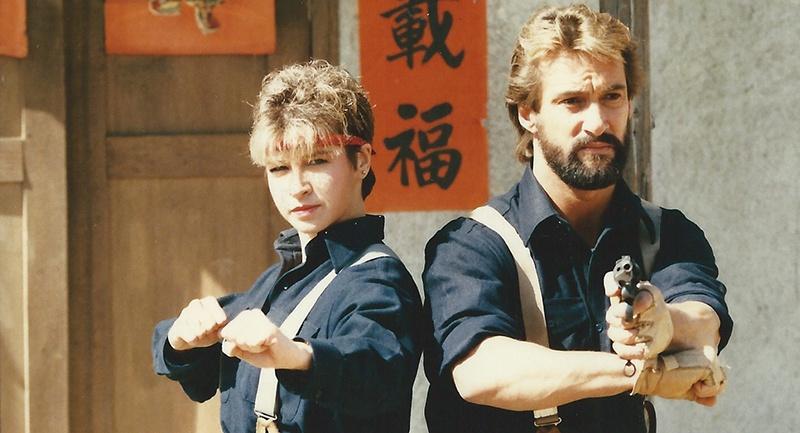
Look in almost any kung fu or martial arts cinema library or archive, and you’re bound to find a documentary of some kind. It helps, however, that there are as many documentaries on the genre as there are, delivered over the years with the last several generations sharing their own respective interpretations on the cinematic art of stunt performance, fisticuffs and stylish whoopass.
What works with director Serge Ou’s offering in Iron Fists And Kung Fu Kicks, is that it takes things just a little bit further in the long run. Essential footage from classic Shaw titles like Come Drink With Me, The Chinese Boxer, Five Fingers Of Death and Shaolin Challenges Ninja are showcased as examples of how Sir Run Run Shaw’s famed company embraced certain creative trends, whereas comparatively, Golden Harvest serviced a more global calling in terms of talent for its annual film output, hiring the likes of Bruce Lee, Jackie Chan and Cynthia Rothrock.
That increasing dichotomy of how both companies operated in lieu of a changing global atmosphere, incorporated with the two camps mitigating how to sustain in a post-Bruce Lee era, is just the tip of the iceberg with Iron Fists And Kung Fu Kicks as the film delves into Golden Harvest’s continued viability and posterity following the imminent collapse of Shaw Studios.
Ou’s documentary continues its journey from the 1970s to today, spanning Hong Kong, New York City, Adelaide in Australia, and all the way to Paris. Outlining the growing trends of Bruceploitation, Blaxploitation and the cross-cultural explosion that saw birth of breakdancing from the evolution of hip-hop and electro rock, the documentary importantly invests in the discussing the connective thread that was the kung fu feature, and how its bustling market became the biggest influencer to young, impoverished urbanites in the Western world.
To this end, it credits kung fu cinema for providing the basis on which Asians and prominently with African Americans can relate, sharing in tropes like challenging the status quo, patriarchy and racism, and rooting for the underdog against powerful men who stood tall with the weak caught in their death grip. Tom Laughlin in Billy Jack (1971) gets a nod in this regard as does Jimmy Wang Yu in The Chinese Boxer (1970), among other titles. It’s as author and film expert Grady Hendrix so stated on the grounds of its appeal to young folks by this period in the late 1960s, the notion that “you could make the world stop and pay attention to you with nothing more than your bare hands.”
Others like Colin Geddes, cinematographer Christopher Doyle and museum curator Warrington Hudlin, and even the likes of Hong Kong stunt legends Sammo Hung, Robert Samuels, Chin Siu Ho and Ridley Tsui Po Wah, and even stars such as Cynthia Rothrock, Billy Blanks, Don “The Dragon” Wilson, Richard Norton, Scott Adkins, Michael Jai White, Jessica Henwick and more, are all among the roster of interviewees for the film’s discussion pieces that comprise the template of the documentary’s m.o..
The documentary takes a spell to discuss how Jimmy Wang Yu’s The Man From Hong Kong came to pass, and later goes on to spotlight North America’s direct-to-video action stardom of 1990s and the imminent crossover of kung fu action as Hong Kong’s economy took a tumble by the turn of the century. It cites The Matrix and Ang Lee’s Crouching Tiger, Hidden Dragon and the evident success of Yuen Woo-Ping, and even the internet boom for creatives taking their craft to YouTube, like performers Amy Johnston and The RackaRacka’s own Danny Philippou.
Things recap with a close look at Indonesia with director Gareth Evans’s reception from The Raid films, and the brewing potential of Uganada’s Wakaliwood production staple, generated and maintained by auteur Nabwana I.G.G.. These areas of focus are slightly abbreviated toward the tail end of the movie, and folks craving for more subject matter on places like India, or even The Philippines may find themselves at more of a loss here.
One might suppose that’s where a potential Iron Fists And Kung Fu Kicks 2 might come in handy if that seed ever gets planted. The Philippines and Indonesia have both proven to be a Mecca for the very meat and potatoes that Hollywood basks in when it comes to its stunt industry auspices, so when it comes to what more ground there may be to educate the masses, it really is worth noting the potential here.
For now, it is with Iron Fists And Kung Fu Kicks that today’s fans of the longstanding and beloved genre looking to teach themselves and their peers, and catalogue their fandom, have a formidable place to start. Anyone with a distinct interest in engaging the topic of kung fu cinema and its pivotal place in the world for the forseeable future will find themselves in pretty good company with Ou’s latest. Of course, there’s still the issue of seeing these films too, so…have at it, kids!

